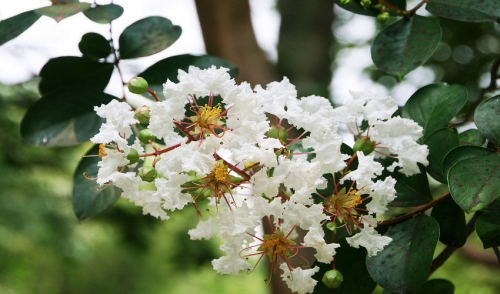
How to Care for Crape Myrtle
For beautiful, long-lasting summer blooms, few plants are as prolific as crape myrtle. But just what do you need to do to ensure these stunning specimens will thrive in your landscape?
About Crape Myrtle
Crape myrtle, also called crepe myrtle or loosestrife, is a group of roughly 50 tree and shrub cultivars in the genus Lagerstroemia. There is great diversity among these plants – some are deciduous while others are evergreen, sizes range from just barely one foot tall dwarf varieties to towering giants that can grow taller than 100 feet, and the native range of the genus spreads from India to Asia, Indonesia and Australia. What they share and what makes all crape myrtles distinct and desirable in landscaping, however, is their stunning frilly, crinkled or rippled blooms as well as peeling bark that gives textural distinction to their trunks and stems as well. Flower colors range from deep purple to lavender, ivory, bright white, pale pink, magenta and red.
Crape myrtles are cultivated worldwide, most often in tropical and subtropical climates where the warm weather helps them to thrive and show off their outstanding beauty. These plants are often used as colorful hedges or privacy screens, while larger plants make amazing focal points and eye-catching specimens in any landscape. Smaller varieties may even be grown in containers.
Proper Care for Crape Myrtle
Crape myrtle is a relatively low-maintenance choice for landscaping in the appropriate region, but they do require some specific care for their showy blooms to flourish. To help your crape myrtle look its very best…
- Find Full Sunlight
Crape myrtle needs full sun (6 or more hours per day) to thrive. With less sunlight, blooms will not be as prolific and their colors may be diminished.
- Use Suitable Soil
These plants are not demanding about the pH of their soil, though neutral or slightly acidic soils are best. Soil must be well-draining, however, as crape myrtle is susceptible to root rot.
- Fertilize Lightly
For brighter flowers and healthy growth, a slow-release fertilizer high in nitrogen is preferred, but avoid too much fertilizing that would promote excessive leaf growth rather than flowers.
- Treat Fungus Before It Starts
Crape myrtle is susceptible to powdery mildew, sooty mold and other fungal infections, and treatment with a general fungicide can reduce the risk of an infected plant.
- Prune Sparingly in Winter or Early Spring
These plants bloom on new wood, so late winter or early spring pruning is essential to promote flowering. Remove suckers, tangled branches or irregular shapes to keep the best size and form.
- Expose the Trunk for More Beauty
Don't miss out on the delicate peeling bark of larger crape myrtles. Prune away branches from the lower 4-5 feet of the trunk to expose the bark for year-round interest.
- Deadhead for Even More Flowers
Early-blooming varieties of crape myrtle can be encouraged to rebloom later in the season with judicious dead-heading, but note that the second bloom will not be as lush as the first.
Crape myrtles can be a stunning addition to any type of landscape, whether you are looking for a colorful hedge, an eye-catching specimen or any burst of floral wonder to add to your yard. Knowing how to properly care for these plants will ensure that you have an amazing show of blooms all summer long.

